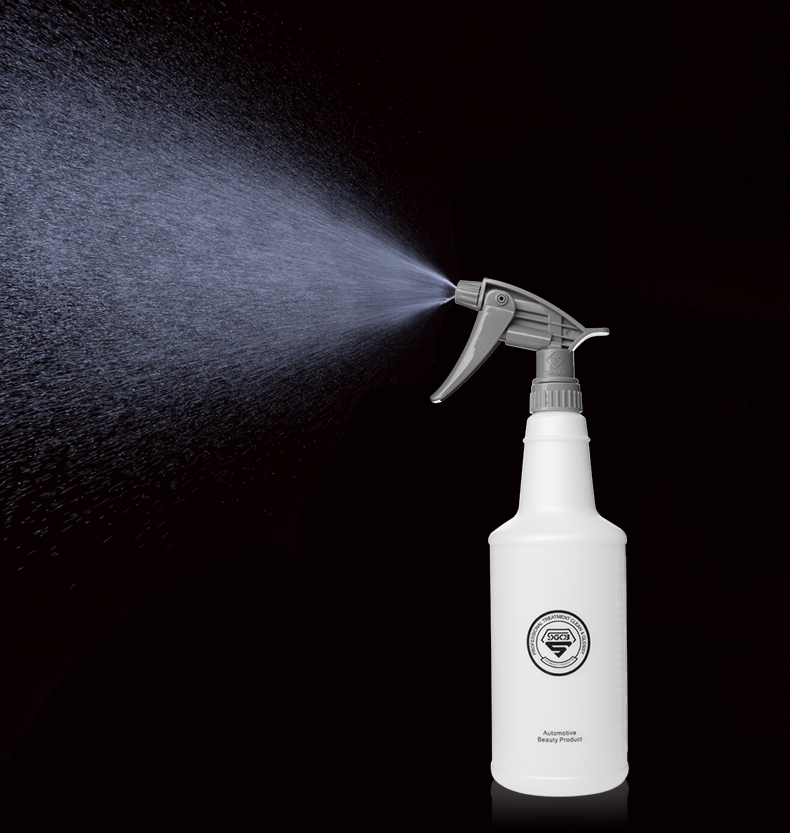In the flotation process of minerals, the solid phase is the sorting object, the liquid phase is the sorting medium, and the gas phase is the sorting carrier. Therefore, this chapter focuses on the structure and properties of each phase of flotation. Natural minerals are divided into two categories according to industrial use: one is industrial minerals and the other is energy minerals. The former is mostly crystalline minerals and the latter is amorphous minerals. The second section of the liquid phase and its properties The third section of the gas phase and its properties
As for bottles, here are three colors:black, grey, and red. the grey color is the best one than other two. all are acid and alkali resistance. It must be cleaning after used it immediatly to prolong life.
If you wanna know more about it, pls contact with us.
Plastic Trigger Spray Bottle,Trigger Bottle Holder,Bottle With Trigger,Spray Bottle Trigger,spray bottle SGCB COMPANY LIMITED , https://www.sgcbautocare.com
 The structure and properties of the first section of the solid phase
First, the fracture surface of mineral crystals
When separating solid phases (ie, various minerals) by flotation, it is usually necessary to first crush and grind to achieve or near the monomer dissociation procedure in the ore and to obtain the appropriate particle size for foam flotation. In order to be able to carry out flotation effectively. During the process of crushing and grinding, the mineral is subjected to external mechanical force, and part of the bond force between the connected particles in the crystal is destroyed ("breaking"), followed by a new irregular "fracture" or relatively smooth " The dissociation surface ", the two are collectively referred to as the fracture surface of the mineral crystal.
Dissociation surface: Strictly breaks into a relatively smooth mineral surface along a certain crystal direction.
Fracture: An uneven surface of a mineral that is not broken by a certain crystal direction.
Factors affecting fracture:
(1) The internal cause, the crystal structure of the mineral, and the decisive factor, the fracture occurs between the meshes with the weakest bonding force along the crystal structure when the mineral is broken.
(2) External factors, that is, the nature ratio of the external force applied by the broken ore and the magnitude and direction of the force. The external force is complex.
Second, the crystal structure of minerals
1, ionic crystal
2, molecular crystal
3, atomic crystal
4, the metal crystals
Third, the unsaturated bond force on the surface of mineral crystals
1. The origin and degree of unsaturation of unsaturated bond forces
The particles that make up the mineral crystal are not only ordered in a certain spatial geometry, but also the vertices are connected to each other by some kind of bond force. The state of the crystal on the surface of the crystal and the inside of the crystal are not the same. The internal ones are in balance, the particles on the fracture surface have unsaturated bond forces, and the unsaturated procedures of the bond forces are also different due to different positions, showing different adsorption capacities and activity. In particular, after the ore is crushed and finely ground, the specific surface area increases, the angular shape formed increases more, and the "active center" of adsorbing other substances is formed more. The finer the finer ore, the adsorption capacity and the active activity. The stronger it is.
2. The type of unsaturated bond force on the mineral surface and its interaction with water molecules.
The primary concern of flotation workers is the nature of the mineral surface being wetted by water, which is related to the type of unsaturated bond force on the mineral surface.
(1) Strong bonding force: covalent bond, ionic bond, metal bond
The particles on the fracture surface have strong polar and chemical activity, polar surface, strong attraction to dipolar water molecules, easy to be wetted by water, and strong hydrophilicity and poor natural floatability. This surface is a hydrophilic surface. Naturally low floatability.
(2) weak bonding force:
The unsaturated bond force exhibited by the fracture surface is mainly intermolecular force, and the polarity is small. It is called a non-polar surface. It has weak interaction with dipolar water molecules, is not easily wetted by water, and exhibits hydrophobicity and easy adsorption to bubbles. Good floatability.
Fourth, the mineral surface unevenness
1. Surface irregularities such as unevenness of the mineral surface and corners.
This macroscopic inhomogeneity also includes pores and cracks, which directly affect surface energy and activity, affect surface hydrophilicity and floatability.
2. Defects in impurity impurities of the mineral crystal itself.
3. Mineral lattice defects.
4. Non-uniformity of mineral surface chemistry.
Flotation is a wet sorting process. The various ions dissolved in water and water have a great influence on the surface properties of minerals and the physicochemical properties of flotation reagents.
The focus of this chapter is on the general nature of liquids and the basic properties of water.
1. Short-range order of particle arrangement in liquid
Around each molecule, due to the effect of intermolecular forces, other molecules can appear in a regular arrangement similar to crystals. And as the distance is large, it gradually destroys until it is eliminated. That is, the planned arrangement of molecules in the liquid is limited to short-range and close-range order. Therefore, the particle distribution in the liquid is an intermediate transition state between completely irregular (ie, gaseous) and fully regular (ie, mixed). The force that promotes the proximity of the liquid endothelium is more complicated. This is not going to be studied in depth.
Second, the surface tension and surface energy of the liquid
In the last section, the physical state of the solid surface and the internal particle are different, the energy state is not the same, and the liquid has a similar situation.

There is a large cohesion (gravitational force) between liquid molecules.
Any molecule inside the liquid, the various gravitational phases are compensated, and the resultant force is zero. However, the molecules of the liquid surface layer cannot be compensated for the internal gravitational force due to the gravitational force in the gas, and the resultant force P is formed. Forming a downwardly extruded surface film on the surface of the liquid to reduce the surface, ie
Form surface gravitation.
If a molecule is to migrate from the inside of the liquid to the surface of the liquid, it must overcome the resultant force inside the liquid. Therefore, the molecules on the liquid surface have excess energy than the molecules inside the liquid, that is, the surface free energy (surface energy becomes interface energy).
The surface energy is equal to the work consumed by the internal molecules of the liquid to migrate to the surface and remove the molecules on the surface, that is, the work required to increase the new surface of the liquid unit. Since increasing the surface of the system requires work, it is necessary to increase the total energy of the system. According to the principle of minimum energy, the liquid can be shrunk as much as possible to reduce its surface area.
The surface tension is equal to the value of the surface energy (specific surface energy) per unit area, but the unit is different. Surface tension δ: N / cm Surface energy J / cm 2 . δ. γ, the surface area S of a liquid, the free energy of the total surface w = δS.
Third, the structure and basic properties of water molecules
Molecular formula: H 2 O.
Structure: Three nucleuses form an isosceles triangle with two protons as the base. The two hybrid orbitals of the oxygen atom form a bond with hydrogen to form two positively charged centers. The two unique pairs of electrons do not form a bond, forming two negative centers. Form a tetrahedral structure. The charge is concentrated on the four top "quadrupoles" of the tetrahedron.
Dipole: The center of the positive and negative charges is far away, which makes the water molecule have a strong dipole moment. Is a strong polar molecule. The water molecule is called a water dipole.
Basic properties:
(1) The density of water is the highest at 4 °C. 4 ° C is slightly above freezing point;
(2) has a high valence constant;
(3) has a high solubility;
(4) low conductivity, but has greater electrode capacity for other compounds;
(5) There is a relatively low dipole moment, and the cooperation is strong;
(6) It has the property of forming a hydrogen bond.
Fourth, the impact of water on the flotation process
1. Association between water molecules
(1) Hydrogen bond association
Due to the quadrupole structure of water molecules, each molecule can form a tetrahedral cage (cavity) structure by hydrogen bonding with four adjacent water molecules, in addition to "solid water-ice structure" and "Flashing cluster" model. These characteristics have an impact on the flotation process. I will talk about it later.
(2) Dipole association
The single molecule association of water dipoles, under the effect of orientation, dispersion and induced response, water molecules are associated. That is, the molecules form a mutual polymerization into a polymer.
![]()
2. The role of water molecules and mineral surfaces
Water molecules are highly polar molecules, which can act on polar surfaces. The result is that the surface of the mineral is hydrated or wet, which seriously affects the contact process between minerals and bubbles.
3, water solubility
The solubility of water plays a very important role in the flotation process, which changes the chemical composition of the mineral surface, the electrical properties of the interface, and the chemical composition of the liquid phase, which changes the behavior of the mineral during the flotation process.
The dissolution process is a complex process, accompanied by complex chemical reactions, so in the flotation process should pay great attention to the role of water on minerals, water quality and the impact of ions on flotation.
There are many factors affecting the dissolution, the ion composition in the liquid, the temperature and the particle size.
The gas phase used in the flotation is mainly air, which acts as a carrier.
First, the composition and solubility of air
Air is a mixture of typical non-polar materials that have a symmetrical structure. Easy to combine non-polar surface.
21% O2, 78% N2, 0.9% Ar (argon), 0.04% CO2 and a small amount of other gases and water vapor.
Solubility sequence in water CO2 > O2 > Ar > N2
The solubility of air in the slurry is related to the pressure, temperature and concentration of other substances dissolved in the water. What makes sense for flotation is the relationship between pressure and solubility.
Henry's Law: The temperature is constant, and the solubility of each component in the mixed gas increases as its partial pressure increases.
Solubility q = KP.
The relationship between temperature and solubility: q = KT-1.
The relationship between the concentration of other substances and q: q = KC-1.
Second, the role and influence of gas phase in flotation
effect:
(1) Carrier action: The main component can be actively adsorbed on the surface of the mineral to produce a special effect, and directly affect the floatability of the ore.
(2) Activator action: The most active of these is oxygen. 


    Mineral flotation is a heterogeneous heterogeneous system in which the mineral is a solid phase, water is a liquid phase, and bubbles are a gas phase. In this heterogeneous system, the interfacial properties of the solid phase, the liquid phase, the gas phase, the interaction of the phases, and the effects of the flotation agent on these phase interfaces determine the direction and speed at which the flotation process proceeds; The nature of the phase interface, the interaction of the phases, and the effects of the flotation agent at these phase interfaces depend on the internal cross-sectional structure and properties of these phases.